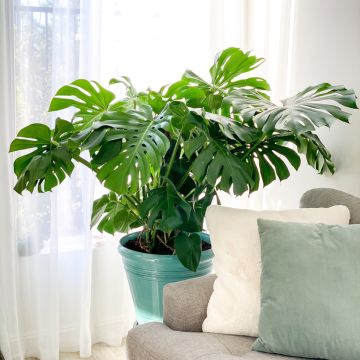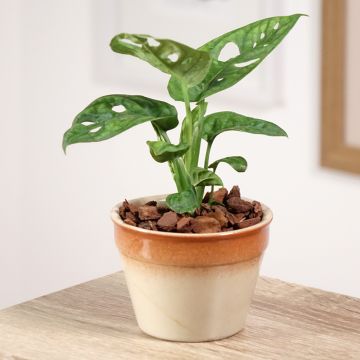

Amydrium medium Silver
Amydrium medium Silver
Amydrium medium Silver
I can't wait to watch this little plant mature, it already has such beautiful coloring and fenestration, it will really be satisfying watching it grow. Looks to be a very healthy baby plant, so I am optimistic about it adapting quickly to it's new home.
Such a beautiful little plant, 29/09/2025
Special offer!
Receive a €20 voucher for any order over €90 (excluding delivery costs, credit notes, and plastic-free options)!
1- Add your favorite plants to your cart.
2- Once you have reached €90, confirm your order (you can even choose the delivery date!).
3- As soon as your order is shipped, you will receive an email containing your voucher code, valid for 3 months (90 days).
Your voucher is unique and can only be used once, for any order with a minimum value of €20, excluding delivery costs.
Can be combined with other current offers, non-divisible and non-refundable.
Why not try an alternative variety in stock?
View all →This plant carries a 30 days recovery warranty
More information
We guarantee the quality of our plants for a full growing cycle, and will replace at our expense any plant that fails to recover under normal climatic and planting conditions.
Description
The Amydrium medium 'Silver' is an extremely original and sought-after houseplant prized for its unique foliage. The plant produces juvenile green leaves that are more or less divided, gradually becoming covered with a delicate silvery sheen. Provide it with a climbing support and it will then develop larger, even more deeply divided, strangely perforated in places leaves, while their colour becomes increasingly silvery. Perfect for adding a tropical touch to your home, this plant, closely related to the Monstera, thrives in warm, humid conditions with bright, indirect light.
The Amydrium is a relatively obscure genus within the vast Araceae family, which includes approximately 3,500 species, mostly found in tropical and subtropical regions. Morphologically, the Amydrium is very similar to the Monstera, another highly popular Araceae. It differs primarily in having two ovules per ovary—a detail invisible to the untrained eye, which explains why they are often confused. The Amydrium genus comprises only five species, native to Southeast Asia, southern China, and New Guinea. These are climbing plants that develop as lianas, clinging to trees or rocks using adhesive roots. The Amydrium medium grows naturally from Myanmar to the Philippines, including other tropical countries such as Thailand and Borneo.
The Amydrium medium 'Silver' is a horticultural variety distinguished, as its name suggests, by its silvery foliage (silver = argent in English). In its juvenile state, the plant exhibits moderate growth, producing medium-sized leaves that are initially whole, roughly the size of a hand, before expanding and developing one, then two or three lobes. The lamina is slightly textured due to prominent primary and secondary veins, and its colour is a striking bright green. As is common with such plants, it needs to reach a certain size before its foliage matures. Stake it with a moss pole to enable it to climb, mimicking its natural tropical habitat. The leaves can then grow up to 30–40 cm long and take on their mature form. Deeply divided, usually with one central lobe and three lobes on either side of the central axis, they also feature fenestrations, much like Monsteras. These perforations, often along the central midrib, may be spherical or irregularly shaped, greatly enhancing the plant's exotic aesthetic. Of course, this cultivar's additional appeal lies in its striking silvery hue which intensifies with age, making it one of the most decorative houseplants. Its mature size depends on available space and potting soil volume—it can reach between 1.50 and 2.50 m in height within 10 years. Though growth starts slowly, it accelerates once established, especially with regular fertilisation.
Though still relatively unknown, the 'Monstera' Amydrium medium 'Silver' more than deserves a place in your home. Provide it with a warm, humid environment, sheltered from draughts and direct sunlight, and its lush appearance will bring a tropical flair to your décor. For a colourful accent, pair it with a pot of Anthurium, whose vibrant —often red or pink— spathes will further enhance the aesthetic. And if space allows, a large Philodendron will make an excellent companion to complete the display.
Report an error about the product description
Foliage
Plant habit
Botanical data
Amydrium
medium
Silver
Araceae
Cultivar or hybrid
Safety measures
Other Monstera
View all →Location
Location
Maintenance and care
Watering tips
Potting advice, substrates and fertilisers
Houseplant care
Disease and pest advice
Maintenance and care
-
, onOrder confirmed
Reply from on Promesse de fleurs
Haven't found what you were looking for?
Hardiness is the lowest winter temperature a plant can endure without suffering serious damage or even dying. However, hardiness is affected by location (a sheltered area, such as a patio), protection (winter cover) and soil type (hardiness is improved by well-drained soil).

Photo Sharing Terms & Conditions
In order to encourage gardeners to interact and share their experiences, Promesse de fleurs offers various media enabling content to be uploaded onto its Site - in particular via the ‘Photo sharing’ module.
The User agrees to refrain from:
- Posting any content that is illegal, prejudicial, insulting, racist, inciteful to hatred, revisionist, contrary to public decency, that infringes on privacy or on the privacy rights of third parties, in particular the publicity rights of persons and goods, intellectual property rights, or the right to privacy.
- Submitting content on behalf of a third party;
- Impersonate the identity of a third party and/or publish any personal information about a third party;
In general, the User undertakes to refrain from any unethical behaviour.
All Content (in particular text, comments, files, images, photos, videos, creative works, etc.), which may be subject to property or intellectual property rights, image or other private rights, shall remain the property of the User, subject to the limited rights granted by the terms of the licence granted by Promesse de fleurs as stated below. Users are at liberty to publish or not to publish such Content on the Site, notably via the ‘Photo Sharing’ facility, and accept that this Content shall be made public and freely accessible, notably on the Internet.
Users further acknowledge, undertake to have ,and guarantee that they hold all necessary rights and permissions to publish such material on the Site, in particular with regard to the legislation in force pertaining to any privacy, property, intellectual property, image, or contractual rights, or rights of any other nature. By publishing such Content on the Site, Users acknowledge accepting full liability as publishers of the Content within the meaning of the law, and grant Promesse de fleurs, free of charge, an inclusive, worldwide licence for the said Content for the entire duration of its publication, including all reproduction, representation, up/downloading, displaying, performing, transmission, and storage rights.
Users also grant permission for their name to be linked to the Content and accept that this link may not always be made available.
By engaging in posting material, Users consent to their Content becoming automatically accessible on the Internet, in particular on other sites and/or blogs and/or web pages of the Promesse de fleurs site, including in particular social pages and the Promesse de fleurs catalogue.
Users may secure the removal of entrusted content free of charge by issuing a simple request via our contact form.
The flowering period indicated on our website applies to countries and regions located in USDA zone 8 (France, the United Kingdom, Ireland, the Netherlands, etc.)
It will vary according to where you live:
- In zones 9 to 10 (Italy, Spain, Greece, etc.), flowering will occur about 2 to 4 weeks earlier.
- In zones 6 to 7 (Germany, Poland, Slovenia, and lower mountainous regions), flowering will be delayed by 2 to 3 weeks.
- In zone 5 (Central Europe, Scandinavia), blooming will be delayed by 3 to 5 weeks.
In temperate climates, pruning of spring-flowering shrubs (forsythia, spireas, etc.) should be done just after flowering.
Pruning of summer-flowering shrubs (Indian Lilac, Perovskia, etc.) can be done in winter or spring.
In cold regions as well as with frost-sensitive plants, avoid pruning too early when severe frosts may still occur.
The planting period indicated on our website applies to countries and regions located in USDA zone 8 (France, United Kingdom, Ireland, Netherlands).
It will vary according to where you live:
- In Mediterranean zones (Marseille, Madrid, Milan, etc.), autumn and winter are the best planting periods.
- In continental zones (Strasbourg, Munich, Vienna, etc.), delay planting by 2 to 3 weeks in spring and bring it forward by 2 to 4 weeks in autumn.
- In mountainous regions (the Alps, Pyrenees, Carpathians, etc.), it is best to plant in late spring (May-June) or late summer (August-September).
The harvesting period indicated on our website applies to countries and regions in USDA zone 8 (France, England, Ireland, the Netherlands).
In colder areas (Scandinavia, Poland, Austria...) fruit and vegetable harvests are likely to be delayed by 3-4 weeks.
In warmer areas (Italy, Spain, Greece, etc.), harvesting will probably take place earlier, depending on weather conditions.
The sowing periods indicated on our website apply to countries and regions within USDA Zone 8 (France, UK, Ireland, Netherlands).
In colder areas (Scandinavia, Poland, Austria...), delay any outdoor sowing by 3-4 weeks, or sow under glass.
In warmer climes (Italy, Spain, Greece, etc.), bring outdoor sowing forward by a few weeks.































